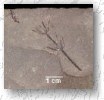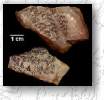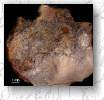Fossil Plants
Following are Pennsylvanian plants collected in in the Cahaba coal field
near a "town" called Marvel north of Montevalo, AL and south-southwest
of Birmingham, AL. The trick is to collect in the bedding shale on either side
of a coal seam, or in the spoil pile left over after strip or shaft mining. The
strip pits where these were collected are not accessible by regular car, and
were it not for the help of one of the locals with a 4x4, we would have gone
home empty-handed.
The plants represented here are Calamites, a giant horsetail
(sphenophyte), and its foliage, assigned to the genus Annularia;
Stigmaria, the rhizome of a lepidodendroid club moss (lycophyte); and
Sphenopteris, a seed fern (pteridosperm).
Click a thumbnail to get a large picture

|
Calamites sp. Note the
"bamboo" like appearance of the stem, with numerous parallel veins and
a jointed stem. Along the joint, one can see two radial scars where smaller
branches split off of the main stem. While the genus Calamites is
extinct, modern horsetails still live today, but at generally under a meter
tall, they do not attain the tree-like proportions (estimated up to 20 meters or
65 feet) of their extinct relatives. |
Annularia sp. The genus Annularia is used
to designate detached foliage most likely attributable to a sphenophyte like
Calamites, if not the actual foliage of Calamites itself. | 
|

| Stigmaria sp. The genus Stigmaria is
assigned to the detached rhizomes (root systems) of lepidodendroid lycophytes (Lepidodendron,
Sigillaria), which, unlike modern lycophytes not reaching heights of
more than a meter, could attain heights of 50 meters (160 feet). Note on the
specimen the circular scars where the roots were attached.
|


Sphenopteris hoeninghausii. Here are
three specimens total of Sphenopteris, a member of the Pteridospermales, or seed
ferns. Seed ferns, rather than reproducing by spores as true ferns do,
reproduced by seeds, a trait that has caused them to be classified as
gymnosperms along with ginkgoes, cycads, pines and the like. There are no known
living seed ferns today.
The two smaller Sphenopteris specimens give a better view of the
finer detail of a Sphenopteris frond, while the larger one gives an
overview of the frond structure ... apparently this larger frond was bent
doubled over itself during preservation (or perhaps a second frond overlayed the
first).
Back to Prem's Fossil Gallery
Trilobites
Graptolites
Fossil Hunting FAQ
Other Paleontology Related Links
Web page design and graphics (except for "award"
graphics) Copyright © 1995, 1996 by Prem Subrahmanyam Graphic Design. All
Rights Reserved. Images on this page may be used for personal use or for
promotion of the presence and content of this page. Images on this page may also
be used at educationally oriented sites provided proper credit is given to the
author. Neither the images nor the contents of this page may be used
commercially without the written permission of the author.




